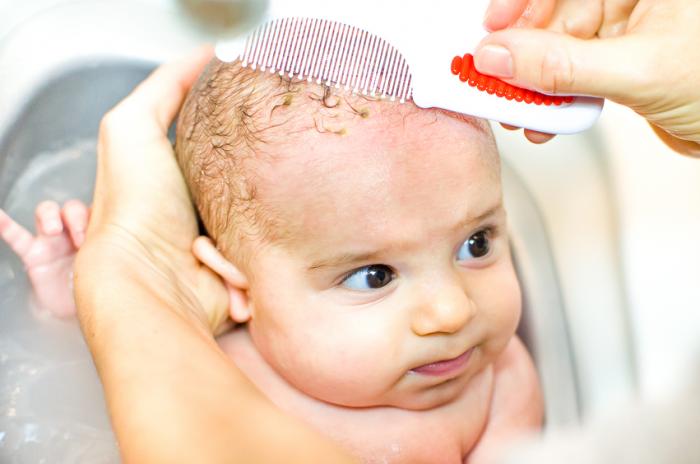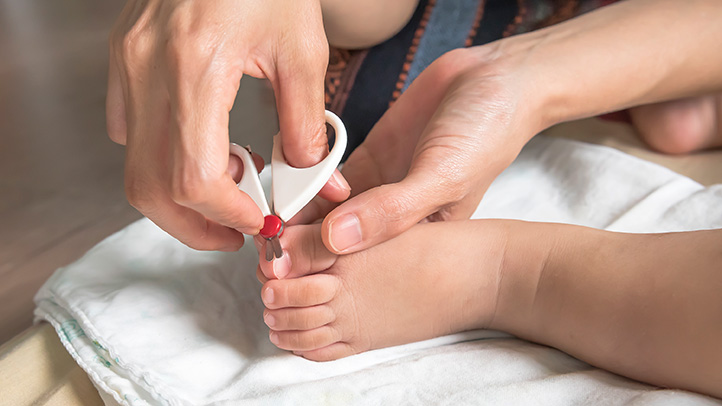Most babies outgrow cradle cap by their first year. It usually resolves without treatment.
Cradle cap, or seborrheic dermatitis, is a common, non-contagious skin condition in infants. It appears as thick, yellowish, or white scales on the scalp. Parents often worry about this condition, but it typically isn’t painful or itchy for the baby.
Regular gentle washing with a mild baby shampoo can help loosen the scales. For more persistent cases, pediatricians may recommend specific treatments. It’s important to avoid picking at the scales to prevent infection. With time and proper care, most babies will outgrow cradle cap naturally. Always consult a healthcare provider if you have concerns about your baby’s skin condition.
Cradle Cap Basics
Cradle cap is a common condition in babies. It usually appears in the first few months. Understanding cradle cap can help parents manage it better. Let’s dive into the basics.
What Is Cradle Cap?
Cradle cap is a type of seborrheic dermatitis. It appears as yellow or white scales on the scalp. This condition is not contagious or painful. Most babies outgrow cradle cap by their first birthday.
Common Symptoms
Cradle cap has several noticeable symptoms. Here are some common signs:
- Scaly patches on the scalp
- Oily or dry skin flakes
- Redness in the affected areas
- Mild itching (but babies usually don’t seem bothered)
| Symptom | Description |
|---|---|
| Scaly patches | Yellow or white scales on the scalp |
| Oily or dry skin flakes | Flaky skin that can be oily or dry |
| Redness | Red areas on the scalp |
| Mild itching | Light itching, but babies are rarely bothered |
Causes Of Cradle Cap
Cradle cap is a common condition in babies. It causes scaly patches on the scalp. Understanding its causes can help manage it better. Here, we will explore the possible triggers and the role of sebum.
Possible Triggers
Many factors might trigger cradle cap. Some potential triggers include:
- Hormones: Hormones from the mother can affect the baby.
- Yeast: Yeast on the skin can lead to cradle cap.
- Weather: Cold weather can make cradle cap worse.
- Genetics: Family history can play a role.
Role Of Sebum
Sebum is an oily substance. It is produced by glands on the scalp. Overproduction of sebum can cause cradle cap. This extra sebum traps skin cells. This leads to scaly patches.
A table below shows the role of sebum:
| Factor | Description |
|---|---|
| Hormones | Can increase sebum production |
| Yeast | Thrives in oily environments |
| Genetics | Can affect sebum levels |
Managing sebum levels can help reduce cradle cap. Use gentle baby shampoos. Regularly clean the baby’s scalp.
Age And Cradle Cap
Cradle cap, also known as infantile seborrheic dermatitis, is a common condition in babies. It appears as scaly, greasy patches on their scalp. Parents often worry if their baby will outgrow cradle cap and when it will disappear.
Typical Age Range
Cradle cap usually affects newborns and infants. It often starts within the first few weeks of life. Most commonly, it appears between 3 weeks and 3 months of age.
| Age Range | Likelihood of Cradle Cap |
|---|---|
| 0-3 months | High |
| 3-6 months | Medium |
| 6-12 months | Low |
| 12+ months | Very Low |
When It Usually Disappears
Cradle cap often resolves on its own. Most babies outgrow it within a few months. Typically, it disappears by the time the baby is 12 months old. Some babies may have it until 1 or 2 years old, but this is rare.
- 3-6 months: Common period for improvement
- 6-12 months: Most cases clear up
- 12+ months: Rare cases may persist
Parents can help manage cradle cap with gentle care. Regular washing with mild shampoo and soft brushing can aid in removing flakes. If the condition persists or worsens, consult a pediatrician.

Credit: www.medicalnewstoday.com
Treatment Options
Cradle cap is a common condition in babies. It appears as crusty or oily patches on the scalp. Many parents wonder if their baby will outgrow cradle cap. The good news is that there are several treatment options available to help manage and treat this condition.
Over-the-counter Solutions
Several over-the-counter products can help treat cradle cap. Look for shampoos containing salicylic acid or zinc pyrithione. These ingredients help reduce the flakes and scales. Apply the shampoo to your baby’s scalp. Leave it on for a few minutes. Then rinse thoroughly.
Moisturizing lotions can also help. Products with mineral oil or petroleum jelly are effective. Apply a small amount to the affected area. This will help soften the scales. After a few hours, gently brush the scalp with a soft brush to remove the flakes.
Home Remedies
Home remedies can be effective for cradle cap. Many parents use natural oils. Examples include coconut oil and olive oil. Apply a small amount to the scalp. Leave it on for 15-20 minutes. Then gently brush the scalp to loosen the flakes.
Another home remedy involves using baking soda. Mix one tablespoon of baking soda with a small amount of water. This creates a paste. Apply the paste to the affected area. Leave it on for a few minutes. Then rinse thoroughly.
Here’s a table summarizing the treatment options:
| Treatment Option | Details |
|---|---|
| Over-the-Counter Shampoos | Contains salicylic acid or zinc pyrithione |
| Moisturizing Lotions | Use products with mineral oil or petroleum jelly |
| Natural Oils | Examples: coconut oil, olive oil |
| Baking Soda Paste | Mix baking soda with water |
These treatment options can help manage and reduce cradle cap. Always consult your pediatrician before starting any treatment.
When To See A Doctor
Cradle cap is common in babies, but sometimes, it needs medical attention. Knowing when to see a doctor can be crucial for your baby’s health. This section will guide you on the signs to watch for.
Signs Of Infection
If you notice any signs of infection, consult a doctor. These signs include:
- Redness: The scalp appears red and inflamed.
- Swelling: The affected area looks swollen.
- Oozing: Fluid or pus is coming from the scalp.
- Fever: Your baby has a fever along with cradle cap.
These symptoms could indicate an infection that needs treatment.
Persistent Cases
Most cradle cap cases improve with simple home care. But if your baby’s cradle cap persists, it might be time to see a doctor. Here are some signs:
- No Improvement: The condition does not improve after a few weeks.
- Spreading: The rash spreads to other parts of the body.
- Discomfort: Your baby seems uncomfortable or irritable.
A doctor can provide stronger treatments to help your baby.
| Symptom | Action |
|---|---|
| Redness and Swelling | See a doctor immediately |
| Oozing or Pus | Consult a healthcare provider |
| Fever | Seek medical advice |
| Persistent Rash | Make an appointment with your doctor |
| Spreading Rash | Get a professional evaluation |

Credit: www.nhs.uk
Preventing Cradle Cap
Cradle cap is common in babies, but it can be prevented. With the right care and products, you can keep your baby’s scalp healthy.
Daily Care Tips
Daily care is key to preventing cradle cap. Follow these tips:
- Gently wash your baby’s scalp with mild baby shampoo.
- Brush your baby’s hair with a soft brush to remove scales.
- Avoid over-bathing, which can dry out the scalp.
Choosing The Right Products
Choosing the right products can make a big difference. Here are some tips:
| Product | Recommendation |
|---|---|
| Shampoo | Use a mild baby shampoo without harsh chemicals. |
| Brush | Choose a soft-bristled brush to avoid irritating the scalp. |
| Moisturizer | Apply a baby-safe moisturizer to keep the scalp hydrated. |
Proper care and the right products can help prevent cradle cap. Keep your baby’s scalp clean and moisturized.
Myths And Facts
Cradle cap is a common condition in babies. It appears as yellow or white scales on the scalp. Parents often worry about it and seek answers. There are many myths surrounding cradle cap. Understanding the facts can help ease concerns.
Common Misconceptions
- Myth: Cradle cap is caused by poor hygiene.
- Fact: Cradle cap is not related to cleanliness. It is due to overactive oil glands.
- Myth: It is contagious.
- Fact: Cradle cap is not contagious. It cannot spread from one baby to another.
- Myth: Only babies get cradle cap.
- Fact: Adults can also get a similar condition called seborrheic dermatitis.
Scientific Insights
Cradle cap often resolves on its own. It usually does not cause discomfort to the baby. Here are some scientific insights:
| Fact | Details |
|---|---|
| Hormones | Maternal hormones can cause overactive oil glands in babies. |
| Self-resolving | Most cases clear up without treatment in a few months. |
| Gentle Care | Using a soft brush and mild shampoo can help manage it. |
Understanding the myths and facts about cradle cap can help parents manage it better. Always consult with a pediatrician for proper advice.

Credit: www.clinikally.com
Long-term Outlook
Parents often worry about the long-term outlook of cradle cap. Understanding the future can ease concerns. Let’s dive into what to expect.
Will It Return?
Most babies outgrow cradle cap by age one. The condition rarely returns. Proper scalp care helps prevent recurrence. Regularly washing the baby’s scalp is key. Use gentle baby shampoos for the best results. Avoid harsh chemicals that may irritate the skin.
Impact On Baby’s Health
Cradle cap is mostly harmless. It doesn’t affect the baby’s health. Babies with cradle cap are usually happy and healthy. The condition is more of a cosmetic issue. Parents should not worry about long-term effects.
| Factor | Impact |
|---|---|
| Scalp Health | Improves with proper care |
| Baby’s Comfort | Generally unaffected |
| Overall Health | Not impacted |
In rare cases, cradle cap may coexist with other skin conditions. Eczema is one such condition. Consult a pediatrician if you notice unusual symptoms.
Frequently Asked Questions
How Long Does A Cradle Cap Take To Go Away?
Cradle cap usually clears up within a few weeks to months. Regular gentle washing helps speed up the process.
What Happens If You Ignore Cradle Cap?
Ignoring cradle cap can lead to persistent scaling and discomfort. Severe cases may cause infection or hair loss. Regular cleaning helps.
What Age Should Cradle Cap Stop?
Cradle cap usually stops by 12 months of age. In some cases, it can last until age 3.
Is It Better To Remove Cradle Cap?
Gently removing cradle cap can be beneficial. Use a soft brush or baby shampoo to help loosen scales. Avoid harsh treatments.
Conclusion
Cradle cap is a common condition in infants. Most babies outgrow it naturally within a few months. Gentle care and proper hygiene can help manage it. Consult your pediatrician for persistent cases. Remember, cradle cap is typically harmless. Your baby will likely outgrow it soon, leaving their scalp healthy and clear.

